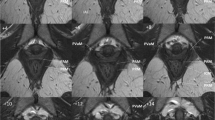Abstract
Introduction and hypothesis
The objective of this study was to compare puborectal muscle integrity and bulk in women with both major levator ani (LA) defects on MRI and pelvic organ prolapse (POP) to women with normal LA muscle and normal support.
Methods
This is a case-control study comparing 24 cases with known major LA defects and POP to 24 controls with normal LA and normal support. Axial T-2 weighted MRI scans of the pelvis were evaluated for integrity of the puborectal muscle and degree of muscle bulk.
Results
There were no significant group differences in age, body mass index, vaginal deliveries, or hysterectomy status. In all 48 subjects, the puborectal muscle was visible and had no disruption noted. There was no difference in muscle bulk between groups (control/case, thin 42% vs. 25%, average 42% vs. 38%, thick-17% vs. 38%; P = 0.47).
Conclusions
Defects and loss of muscle bulk in the puborectal muscle are not seen on MRI in women with major LA defects and POP.



Similar content being viewed by others
References
Terminologia anatomica = International anatomical terminology. 1998, Stuttgart: Thieme. x,292p.
Kearney R, Sawhney R, DeLancey JO (2004) Levator ani muscle anatomy evaluated by origin-insertion pairs. Obstet Gynecol 104(1):168–173
Lawson JO (1974) Pelvic anatomy. I. Pelvic floor muscles. Ann R Coll Surg Engl 54(5):244–252
Dietz HP, Lanzarone V (2005) Levator trauma after vaginal delivery. Obstet Gynecol 106(4):707–712
DeLancey JO et al (2007) Comparison of levator ani muscle defects and function in women with and without pelvic organ prolapse. Obstet Gynecol 109(2 Pt 1):295–302
Piloni V et al (1999) Measurement of the anorectal angle by defecography for the diagnosis of fecal incontinence. Int J Colorectal Dis 14(2):131–135
Shobeiri SA et al (2009) Appearance of the levator ani muscle subdivisions in endovaginal three-dimensional ultrasonography. Obstet Gynecol 114(1):66–72
Margulies RU et al (2006) Appearance of the levator ani muscle subdivisions in magnetic resonance images. Obstet Gynecol 107(5):1064–1069
DeLancey JO et al (2008) Stress urinary incontinence: relative importance of urethral support and urethral closure pressure. J Urol 179(6):2286–2290, discussion 2290
Kearney R et al (2006) Obstetric factors associated with levator ani muscle injury after vaginal birth. Obstet Gynecol 107(1):144–149
Morgan DM et al (2007) Interrater reliability of assessing levator ani muscle defects with magnetic resonance images. Int Urogynecol J Pelvic Floor Dysfunct 18(7):773–778
DeLancey JO et al (2003) The appearance of levator ani muscle abnormalities in magnetic resonance images after vaginal delivery. Obstet Gynecol 101(1):46–53
Lien KC et al (2004) Levator ani muscle stretch induced by simulated vaginal birth. Obstet Gynecol 103(1):31–40
Hsu Y et al (2006) Quantification of levator ani cross-sectional area differences between women with and those without prolapse. Obstet Gynecol 108(4):879–883
Acknowledgments
This project was funded by National Institute of Childhood Diseases and National Institute 38865 and Office for Research on Women’s Health’s SCOR on Sex and Gender Factors Affecting Women’s Health P50 HD044406.
Conflict of interest
None.
Author information
Authors and Affiliations
Corresponding author
Rights and permissions
About this article
Cite this article
DeLancey, J.O.L., Sørensen, H.C., Lewicky-Gaupp, C. et al. Comparison of the puborectal muscle on MRI in women with POP and levator ani defects with those with normal support and no defect. Int Urogynecol J 23, 73–77 (2012). https://doi.org/10.1007/s00192-011-1527-8
Received:
Accepted:
Published:
Issue Date:
DOI: https://doi.org/10.1007/s00192-011-1527-8




